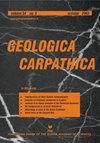Zircon U–Pb geochronology from Permian rocks of the Tribeč Mts. (Western Carpathians, Slovakia)
IF 1.5
4区 地球科学
Q4 GEOSCIENCES, MULTIDISCIPLINARY
引用次数: 4
Abstract
U–Pb dating of magmatic zircons from the Permian basaltic metaandesites/metabasalts of the Tribeč Mts. yielded the Concordia ages of 263.1±2.6 Ma, which correspond to the Guadalupian Epoch in the time span of the uppermost Wordian/Capitanian Stages. These magmatic zircon ages clearly document the timing of the Mid-Permian lithospheric extension in the internal zone of the Variscan fragments in the Western Carpathians. The studied volcanic rocks with the associated metasediments belong to the Veporic Unit that overthrusts the Tatric Unit. The considered sequence was correlated with the Northern Veporic Permian rocks from the Čierťaž Mts. From the geochemical point of view, the studied volcanic rocks have a calc-alkaline magmatic trend with an affinity to continental within-plate tectonic setting, linked to the post-orogenic lithospheric extension. The detrital zircon population, obtained from the associated arkosic metagreywackes, displays mainly Tournaisian and Ediacaran zircon ages in the range of 342–367 and 546–631 Ma, respectively. Only a small number of Cambrian/Ordovician (499–466 Ma), Tonian (720–1000 Ma) and Paleoproterozoic/ Neoarchean (~1.9 Ga and ~2.5 Ga) zircon ages were determined. The similar association of zircon ages was found within the xenocrystic cores in the studied volcanic rocks. The presented detrital and xenocrystic zircon ages specify the provenance of the Tribeč Permian deposits from the Western Carpathian Crystalline Basement crust, characteristic of derivation from the Variscan magmatic rocks and reworked fragments of Cadomian crust.TribečMts二叠纪岩石的锆石U–Pb地质年代学(斯洛伐克喀尔巴阡山脉西部)
TribečMts二叠纪玄武岩变安山岩/变玄武岩的岩浆锆石的U–Pb定年得出了263.1±2.6 Ma的Concordia年龄,对应于最上华兹安阶/卡皮坦阶时间跨度内的瓜达卢皮阶。这些岩浆锆石年龄清楚地记录了喀尔巴阡山脉西部华力西断层内部区域二叠纪中期岩石圈伸展的时间。所研究的火山岩和相关的变质沉积物属于Veporic单元,它推翻了Tatric单元。所考虑的序列与ČierťažMts的北维波期二叠纪岩石相关。从地球化学角度来看,所研究的火山岩具有钙碱性岩浆趋势,与造山后岩石圈伸展有关,与板块内大陆构造环境具有亲和力。碎屑锆石群,从相关的长石砂岩变杂砂岩中获得,主要显示图尔奈期和埃迪卡拉期锆石年龄,分别在342–367和546–631 Ma之间。仅确定了少量寒武纪/奥陶纪(499–466 Ma)、托尼安纪(720–1000 Ma)和古元古代/新太古代(~1.9 Ga和~2.5 Ga)锆石年龄。在所研究的火山岩的捕虏晶岩芯中发现了类似的锆石年龄组合。所提供的碎屑和捕虏晶锆石年龄说明了西喀尔巴阡结晶基底地壳的Tribeč二叠纪矿床的来源,其特征是源自华力西期岩浆岩和卡多米亚地壳的改造碎片。
本文章由计算机程序翻译,如有差异,请以英文原文为准。
求助全文
约1分钟内获得全文
求助全文
来源期刊

Geologica Carpathica
地学-地球科学综合
CiteScore
2.40
自引率
23.10%
发文量
26
审稿时长
>12 weeks
期刊介绍:
GEOLOGICA CARPATHICA covers a wide spectrum of geological disciplines including geodynamics, tectonics and structural geology, volcanology, stratigraphy, geochronology and isotopic geology, karstology, geochemistry, mineralogy, petrology, lithology and sedimentology, paleogeography, paleoecology, paleobiology and paleontology, paleomagnetism, magnetostratigraphy and other branches of applied geophysics, economic and environmental geology, experimental and theoretical geoscientific studies. Geologica Carpathica , with its 60 year old tradition, presents high-quality research papers devoted to all aspects not only of the Alpine-Carpathian-Balkanian geoscience but also with adjacent regions originated from the Mediterranean Tethys and its continental foreland. Geologica Carpathica is an Official Journal of the Carpathian-Balkan Geological Association.
 求助内容:
求助内容: 应助结果提醒方式:
应助结果提醒方式:


